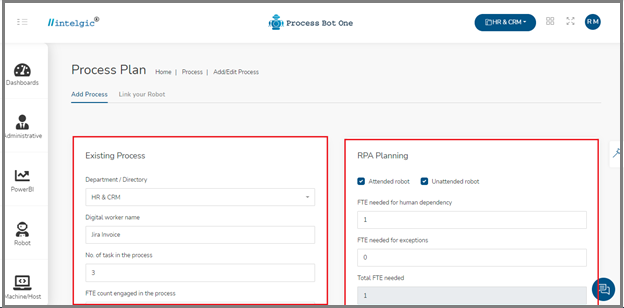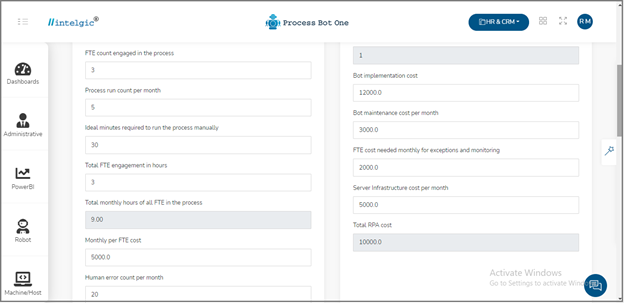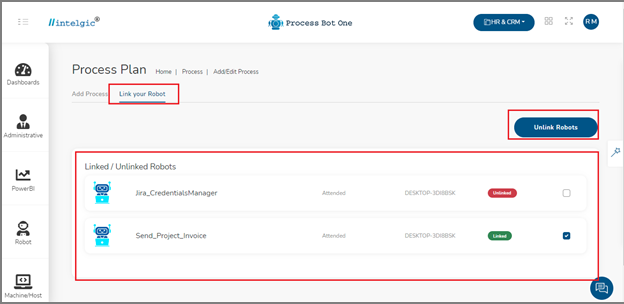ROI stands for Return On Investment. Return on investment (ROI) is a performance metric that is used to assess an investment’s efficiency or profitability, as well as to compare the efficiency of various investments. The term “return on investment” (ROI) refers to a method of calculating the amount of profit made on a given investment in relation to its cost.
Once you click on the ROI calculator the below image will open, which is having two sections, namely, Live Process and Process Planner.
- Live Process: Which shows the process which is currently live.
- Process Planner: This shows the approximate time has been saved and how much the human work got reduced, etc…
- Creating a process will give you an approximate value of Pre and Post RPA implementation.
- To create a Process, first, log in to Process Bot One using your login credentials.
- Once, the Process Bot One window will open, scroll down the left menu bar and click on the Process button.

- Next, click on the Process Planner, you can see different data variables available under Process Planner.

- Click on the + Process button to create a Process, A new Process Planner window will open.
- The Process Planner window has two sections respectively, Existing Process and RPA Planning.
- The Existing Process is a pre-RPA implementation process section, that contains the below fields:
- INFO: Stands for “full-time equivalent.” It refers to the number of hours worked by a single employee in a week.
- Department/Directory: It refers to the name of the department/directory for which you want to create a process.
- Digital Worker Name: It refers to the name of the digital worker who holds this process. If you create a digital worker then only you can see ROI visualization for this process.
- of a task in the Process: It refers to the total number of tasks that are present in your current process.
- FTE count engaged in the process: Refers to the total number of FTE engaged in the process.
- Process run count per month: It refers to the total number of processes running in a month.
- Ideal minutes required to run the process manually: It refers to the average time required to run a process manually.
- Total FTE engagement in hours: This refers to the total number of FTE working in an hour.
- Total monthly hours of all the FTE in the process: Refers to an average of the total number of FTE working in a month.
- Monthly per FTE cost: This refers to an average cost of FTE per month.
- The next is the RPA planning section, which contains the fields that are included after the implementation of the RPA in your business.
- You can select either attended or unattended robot as per your requirement and the fields are as below:
- FTE needed for human dependency: It refers to the total number of FTE needed for human dependency.
- FTE needed for exceptions: It refers to the total number of FTE needed for exception handling.
- Total FTE needed: It refers to the total number of FTE required for your business.
- Bot implantation cost: It refers to the total implementation cost of the bot.
- FET cost needed monthly for exceptions and monitoring: It refers to the monthly maintenance cost required for exception handling and monitoring.
- Server infrastructure cost per month: It refers to the total Infrastructure cost of the RPA server per month.
- Total RPA cost: It refers to the total implementation cost of RPA.
- Enter the required details in the given fields and click on Save. The image is shown below.


- Now the process has been created.
- If the process is not live, we have to link this process to the robot to make it live.
- Each process is associated with one robot.
- As soon as you click on the save, you are navigating to the link your robot
- You can select the robots from the list and click on the Link Robots
- If you want to unlink any robot, then click on the Unlink Robots
- Once you unlink any process/robot then all the log details which is present inside the process will be deleted automatically.

- To verify whether the robot is live or not, go to the published robot under Robot, you will find the green link mark before the digital worker name which is as shown below.

